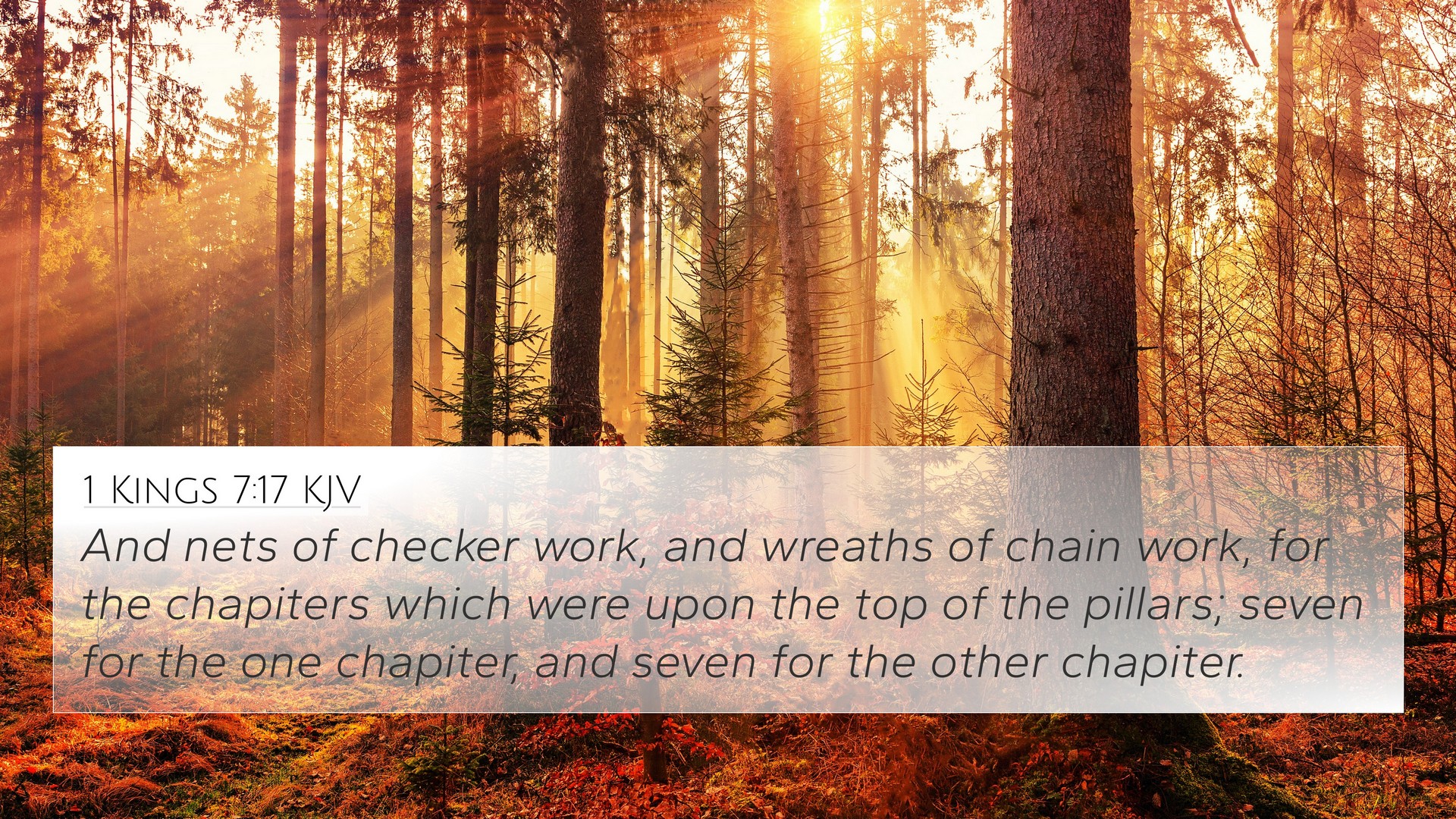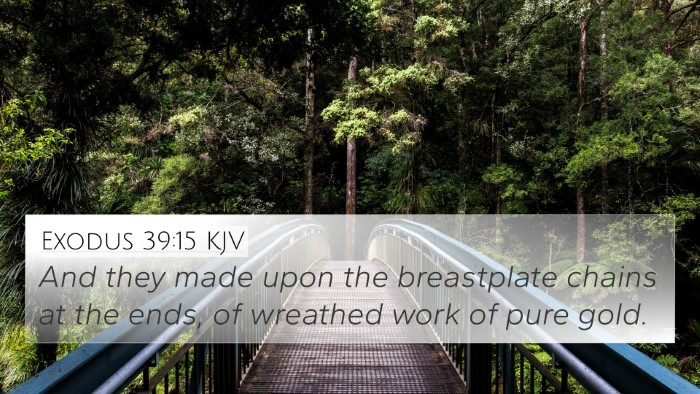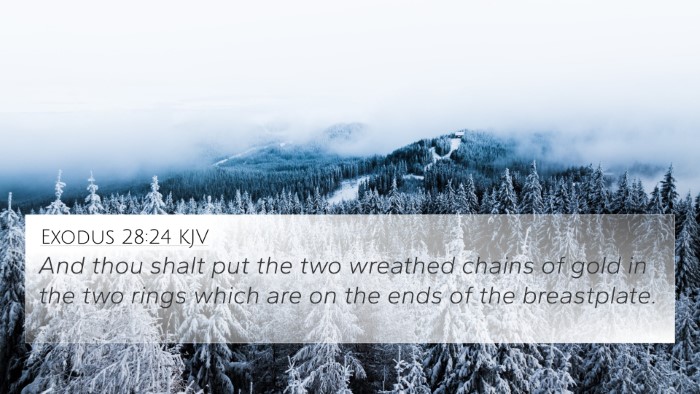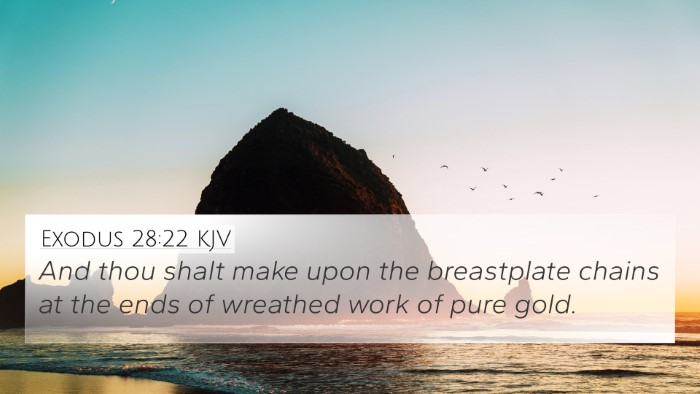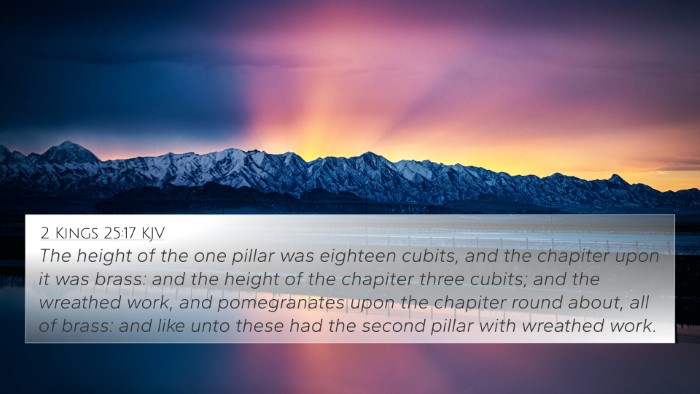Understanding 1 Kings 7:17
1 Kings 7:17 states:
"And he made a chapiter of molten brass; the height of it was five cubits, and the network and pomegranates upon the chapiter round about, all of brass: the second pillar also and the pomegranates were like unto these." (1 Kings 7:17, KJV)
This verse describes the craftsmanship of a significant decorative piece in Solomon's temple, specifically the pillars and their capitals (or chapiters). The artistry signifies both the beauty of the temple and the elaborate nature of worship in ancient Israel.
Significance of the Chapiter
The chapiter, or capital, is an important architectural feature that symbolizes strength and beauty. According to Matthew Henry, the chapiters demonstrate the grandeur of Solomon's temple, reflecting God's glory through its elaborate design. The mention of pomegranates also carries deep symbolism in the Bible, often representing fruitfulness and blessing.
Adam Clarke elaborates that the choice of brass highlights the durability of what is meant to represent God's eternal presence among His people. The number of pomegranates adorning the chapiters signifies prosperity and fertility.
Biblical Context
This verse falls within a larger narrative about the construction of the temple, built as a dwelling place for the Lord. Albert Barnes notes that the context of 1 Kings illustrates the meticulous attention given to the temple's details, something that speaks to the reverence of God’s house. This specific focus on decoration also sets the tone for how seriously the Israelites viewed their worship practices.
Connections to Other Bible Verses
The symbolism and craftsmanship seen in 1 Kings 7:17 can be cross-referenced with several other biblical passages, including:
- Exodus 28:33-34 - Discusses the design of the garments of the priests, including pomegranates.
- 2 Chronicles 3:16 - Describes similar structures and details in temple construction, emphasizing the consistency of design in the sacred spaces.
- Jeremiah 52:22 - Details the pillars' dimensions and adornments, affirming the significance of these elements in God’s sanctuary.
- Psalms 92:12-15 - Pomegranates are symbolically related to the flourishing of the righteous.
- Song of Solomon 4:13-14 - Beautifully describes a garden full of pomegranates, symbolizing love and beauty.
- Revelation 21:18-20 - The New Jerusalem incorporates elements of diverse stones, correlating with the beauty of God's dwelling place.
- Ezekiel 40:22 - Describes worship features similar to those in 1 Kings, examining the continuity of God's architectural visions.
- Hebrews 9:1-5 - Compares the earthly tabernacle to the heavenly one, connecting the significance of sacred spaces across covenants.
- 1 Corinthians 3:16-17 - Indicates that believers are now the temple of the Holy Spirit, echoing the importance of sacred design and holiness.
- Matthew 12:6 - Jesus states that He is greater than the temple, drawing a contrast to its magnificence.
Insights on Thematic Connections
The understanding of 1 Kings 7:17 can further be deepened through thematic analysis:
- Beauty in Worship - The artistic details of the temple reflect a passion for honoring God, inspiring believers today to consider how beauty is integrated into worship.
- Symbolism of Fruitfulness - Pomegranates symbolize abundance, linking to themes of spiritual fertility and growth in the believer's life.
- Divine Presence and Holiness - The intricate designs serve as reminders of God’s holiness and the sanctity of places of worship.
Tools for Bible Cross-Referencing
To fully utilize Bible cross-referencing, believers can access various tools and resources such as:
- Bible Concordance - A reference tool that lists words and their occurrences throughout Scripture.
- Cross-Reference Bible Study Guides - Manuals designed to help readers systematically explore parallels and connections.
- Comprehensive Bible Cross-Reference Materials - Collections of biblical texts linked thematically or contextually.
Conclusion
In summary, 1 Kings 7:17 encapsulates the richness of God's dwelling place through details that convey strength, beauty, and divine purpose. By employing a cross-referencing approach, believers can explore connections within Scripture that enhance understanding and foster spiritual growth. Engaging with the Bible's interconnectedness illuminates the themes of worship, divine presence, and the flourishing life that God desires for His people.
